|
|
Parks in Barcelona - Parc Güell, Ciutadella
In Barcelona,there is a big number of small parks and gardens that the local people like to use for a siesta. But most of these park complexes are dry and are rather deterrend, as a coloured flora can only flower out by artificial irrigation. But there are two big park complexes that should not be missed by any tourist: the Parc Güell and the Parc de la Ciutadella. Of course there is still the huge park complex Montjuïc, but there is a separate page about it. Parc de la Ciutadella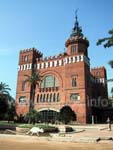
At the north side of the headland Barceloneta and at the east of the oldtown there is the approximately 30 ha sized Parc de la Ciutadella, in English citadel park; Where does this strange name for a park come from? The subway station of the line 4 at the southern end of the park, is it also called Ciutadella, respectively? In the year 1715, Philipp V. founded a fortification on this complex after he conquered Barcelona. The fortification served as a prision and, at the same time, as a determent for the rebelling Catalan population; Not until the year 1878, the citadel was given up and a park was founded at its place. In the year 1888, the first world exhibition in Barcelona took place on this complex; the northern triumphal arc (Arc de Triomf) formed the entrance portal to the exhibition building. 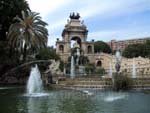
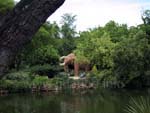
Today, the visitor finds a beautiful park on this complex that either invites for a sightseeing as also for relaxing. How does one get into the park? What a silly question, one might think, as the park is surrounded by traffic roads with a lot of parking places. At the most south-eastern end, there is the subway station Ciutadella. Then, one has to walk, as within the whole eastern and southern wall o the park there is not one single entrance! One either gets at the west or at the north into the park! Thus, the best is to take the subway up to the station Arc de Triomf, visit the fascinating triumphal arc and then access the park at the northern entry. I mention this due to the reason that I first walk alongside half of the park from the outer side in this extremely hot weather until I found an entrance. 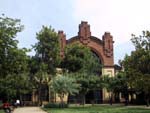
At the northern entrance of the park one immediately comes across to zoological museum. The construction rather reminds on castles in the air of the Renaissance time as on a museum building. I would not waste too much time in the museum, as already some metres further, a bombastic waterfall-cascade waits for one that is adorned with all possible animal figures and offers some nice water Games. It is latest here where everybody makes the first picture of the park. 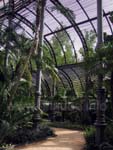
By going further down the park one comes across to a little lake surrounded by some nice plants, trees and bushes. Here, one can relax a little when the legs get already tired. The walk should be continued at the right side than at the west side of the park, as at the left one only finds the Catalan House of Parliaments. But at the west side of the park one comes across to two well worth seeing sightseeings. There is, for example, the Hivernacle, a kind of glass house with cast-iron supports. In its interior, there is a small coffee bar. It is good fun to have an espresso in this nice atmosphere. But what is much more impressive is the neighboured palm house, an approximately 100 years old pavillon with palms of a height of several metres and other exotic plants in its interior. The entrance is free of charge, one walks on a little round through the plant variety. In the whole southern parking area there is the zoo of Barcelona; this is why there is also no southern entry to the park. For a zoo visit, the time in Barcelona is much too precious; compared to other zoos, this is very small. Parc GüellA visit of the Parc Güell is a must of every visit to Barcelona, no matter if it is for one or for several days; As in the Parc Güell, one gets either a presentation of the master performances of Antoni Gaudí as also some nice sports of nature as also a breathtaking panorama view to the city Barcelona for free. This is why the tourist masses push into the park. But those who take a little more time and have a walk in the park will even find some calmed places where only few tourists get lost - it is hard to believe after having experienced the pushing in the column hall and on the observation deck. 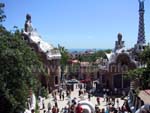
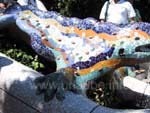
The Parc Güell was arranged within the first 15 years of the last century, thus between 1900 and 1914. Originally, the park was planned to be a large residental area with a garden complex. In this park, Antoni Gaudí could let its talent out as he wanted. Here, also the layman recognizes that Gaudí was not only a great arquitect but also an extravagant, creative artist. Antoni Gaudí himself, he lived in the Parc Güell for some time; today, there is a small museum in his residential house. Why is the park then called Parc Güell and not Parc Gaudí? Well, someone also had to pay the creative activities of Gaudí, and this was a certain Mister Eusebi Güell. 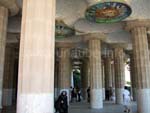
How does one get to the Parc Güell? With the subway line 3 from the Placa de Catalunya up to the station Lesseps. From the metro station, there is still a footway of approximately 1.500 m to go. This way is signposted so well that one will not get lost; Every few metres, some signpostings indicate the direction to go and the remaining way to go in metres. The last ascend is a little burdensome when the sun burns; but there are some resturants and sellers of ice cream inviting to have a rest. Once arrived in the Parc Güell, one comes across to a big entrance portal and a little forecourt, where the tourists fight for each square metre of space. The guard house, squiggled in a funny way, is located at the entrance and beside it, there is a not less squiggled coloured tower. At this point, one already knows what is awaiting in the park. From the entrance area, some double stairs lead to the column hall. But before that, one has to pass a guarding mosaic-dragon that is located in the mid of the stairs. 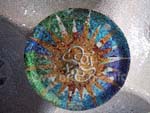
In the shady column hall, one can perfectly recover from the strains of the ascend to the Parc Güell. Here, one suddenly feels s being in the old Greece. Wide columns support the arched slab that in some parts is decorated with wonderfully, exquisitly colourful mosaics. Some further small stairs lead up to the big observation deck over the column hall - the highlight of the visit of the Parc Güell. The big observation deck is surrounded by a wave-shaped bench that does not only serve as a border of the place but also as a bench for having a rest. The bench is adorned with tiny pottery tiles and forms a work of art of its own. But one will not be able to look for a long time at the bench, as in the background, the city of Barcelona shines. From here, one has a breathtaking view down to the city, the harbour and the whole coast. Of course, it is the dream of all tourists to make a picture of oneself sitting on the empty bench with the panorama city in the background. But with these daily tourist masses, the wish is seldom fulfilled. 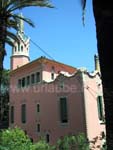
For many tourists, the visit of the park ends on this observation deck. Many take a small and expensive snack in the self service restaurant and some few still get lost up to the residence of Gaudí, where he lived between 1906 and 1926. In this house, there is a little museum where one can gaze at some furniture and drawings of the genius. 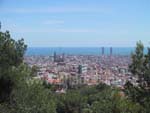
But the Parc Güell offers much more than adorned small houses, mosaics, a column hall, stairs and observation deck. As there, where the masses of tourism end, the relaxing area of the park begins. Those who walk up the mountain from the observation deck will find some calmness and nature. Of course, one still comes across to one or two tourists but there are no masses pushing each other any more. Those who think that the view from the terrace is already great will be amazed by going to the very top of the hill. Those who do the effort to ascend will suddenly not look to the city through trees but will have an allround-panorama to the city and the mountains behind it. If the view from the mosaic-bench terrace is already great, the view from the very top is simply unsurpassable. One tip: not to buy the overpriced fasst-food that is available behind the observation deck, but bring some provisions to this place and enjoy them by having an unforgettable panorama view to the top of the Parc Güell. 
Copyright: Patrick Wagner, www.tourist-guide.biz |
||